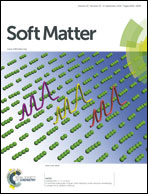Interaction of pepsin–[C16mim]Br system: interfacial dilational rheology and conformational studies
Abstract
The interfacial rheological property is closely related to the stabilities of foams and emulsions, yet there have been limited studies on the interaction between proteins with ionic liquid-type imidazolium surfactants at the decane–water interface as well as in the bulk. Herein, we investigated the interfacial and bulk properties of pepsin (PEP) and an ionic liquid (IL), 1-hexadecyl-3-methylimidazolium bromide, [C16mim]Br. The interfacial pressure and dilational rheology studies were performed to describe the formation of [C16mim]Br–pepsin complexes. The influence of the oscillating frequency and the bulk concentration of [C16mim]Br on the dilational properties were explored. The conformational changes were studied by monitoring the fluorescence and far UV-CD spectra. The results reveal that the globular structure of pepsin is one of the decisive factors controlling the nature of the interfacial film. The monotonous increase in the dilational elastic modulus of pepsin–[C16mim]Br solutions with the surface age indicates that no loops and tails had formed. Interestingly, with an increase in the concentration of [C16mim]Br, the εd–c curve first passes through a plateau value due to steric hindrance and the electrostatic barrier of already absorbed tenacious pepsin–[C16mim]Br complexes. With the further addition of [C16mim]Br, the remarkable decrease in dilational elastic modulus indicates that the compact structure is destroyed gradually. The results of the fluorescence spectra and far UV-CD spectra confirm that [C16mim]Br did not produce perceptible changes in pepsin at the concentrations studied in the dilational experiment. Possible schematic programs of the pepsin–[C16mim]Br interaction model at the interface and in bulk phase are proposed.
![Graphical abstract: Interaction of pepsin–[C16mim]Br system: interfacial dilational rheology and conformational studies](/en/Image/Get?imageInfo.ImageType=GA&imageInfo.ImageIdentifier.ManuscriptID=C4SM00950A&imageInfo.ImageIdentifier.Year=2014)

 Please wait while we load your content...
Please wait while we load your content...